CHEVROLET BLAZER 1998 2.G Manual Online
Manufacturer: CHEVROLET, Model Year: 1998, Model line: BLAZER, Model: CHEVROLET BLAZER 1998 2.GPages: 416, PDF Size: 22.4 MB
Page 81 of 416
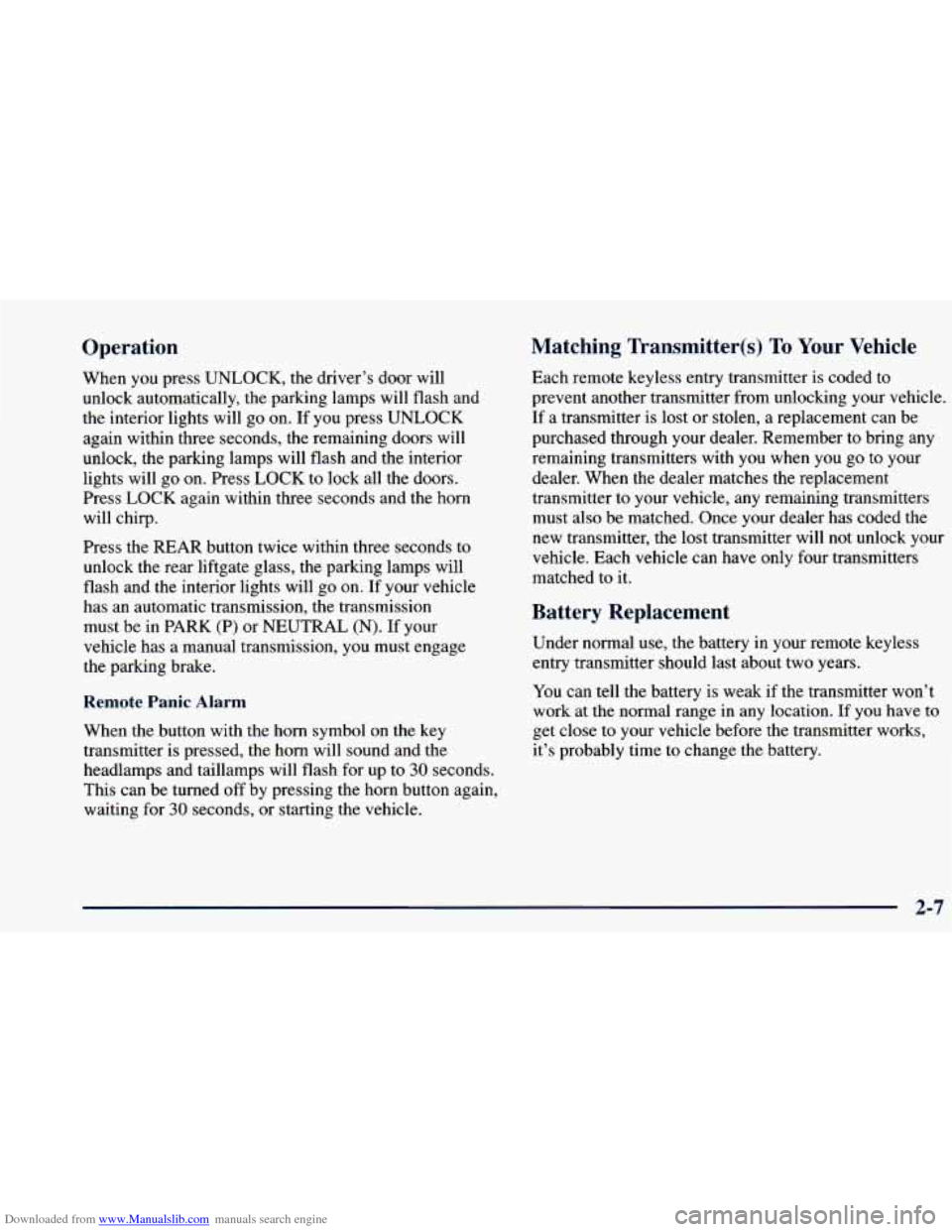
Downloaded from www.Manualslib.com manuals search engine Operation Matching Transmitter(s) To Your Vehicle
When you
press UNLOCK, the driver’s door will
unlock automatically, the parking lamps will flash and
the interior lights will go on. If you press UNLOCK
again within three seconds, the remaining doors will
unlock, the parking lamps will flash and the interior
lights will go on. Press LOCK to
lock all the doors.
Press LOCK again within three seconds and the horn
will chirp.
Press the REAR button twice within three seconds to
unlock the rear liftgate glass, the parking lamps will
flash and the interior lights will go on. If your vehicle
has an automatic transmission, the transmission
must be in PARK
(P) or NEUTRAL (N). If your
vehicle has a manual transmission, you must engage
the parking brake.
Remote Panic Alarm
When the button with the horn symbol on the key
transmitter is pressed, the horn will sound and the
headlamps and taillamps will flash for up to
30 seconds.
This can be turned off by pressing the horn button again,
waiting for
30 seconds, or starting the vehicle. Each
remote keyless entry transmitter is coded to
prevent another transmitter from unlocking your vehicle.
If a transmitter is lost or stolen, a replacement can be
purchased through your dealer. Remember to bring
any
remaining transmitters with you when you go to your
dealer. When the dealer matches the replacement
transmitter to your vehicle, any remaining transmitters
must also be matched. Once your dealer has coded the
new transmitter, the lost transmitter will not unlock your
vehicle. Each vehicle can have only four transmitters
matched
to it.
Battery Replacement
Under normal use, the battery in your remote keyless
entry transmitter should last about two years.
You
can tell the battery is weak if the transmitter won’t
work at
the normal range in any location. If you have to
get close to your vehicle before the transmitter works,
it’s probably time to change the battery.
2-7
Page 82 of 416
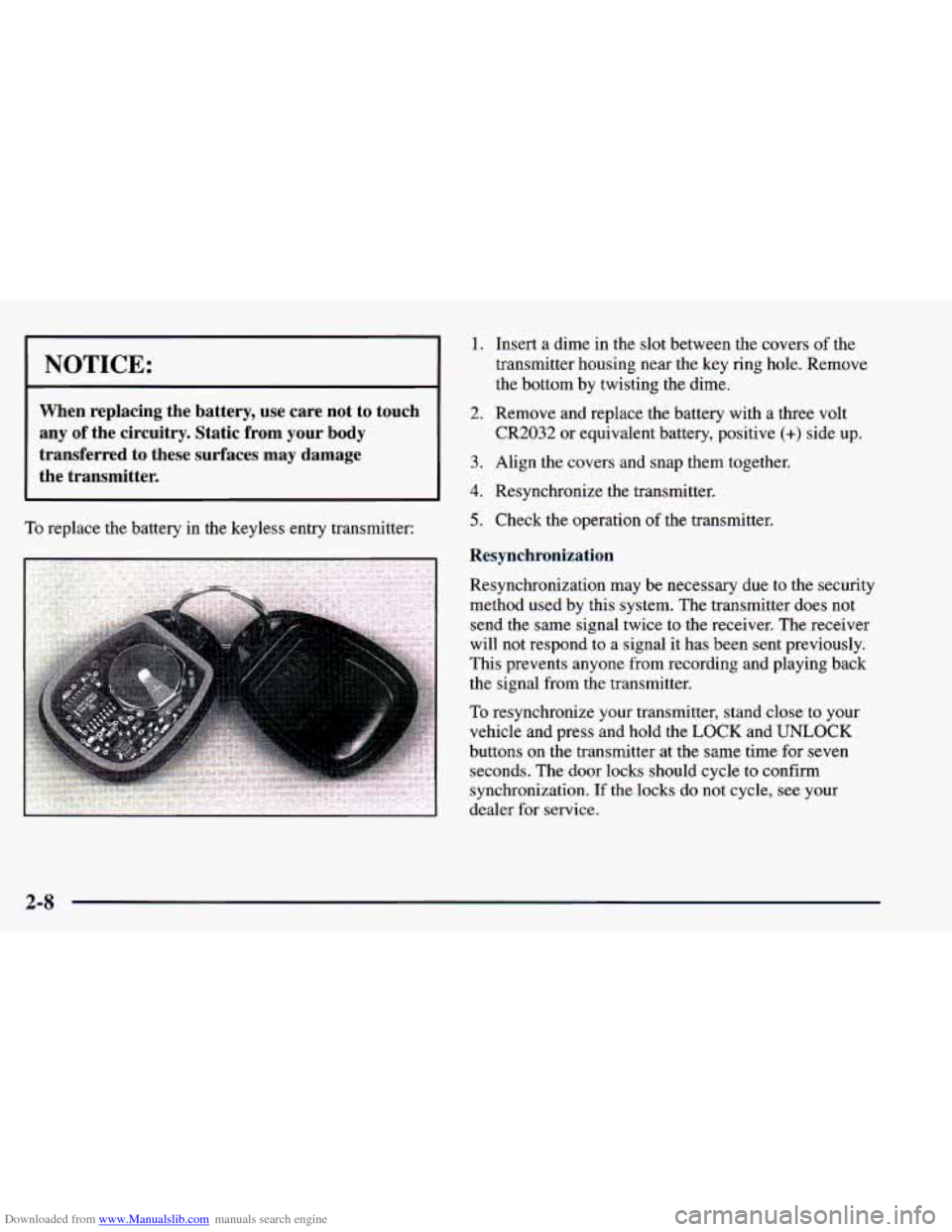
Downloaded from www.Manualslib.com manuals search engine NOTICE:
When replacing the battery, use care not to touch
any of the circuitry. Static from your body
transferred to these surfaces may damage
the transmitter.
To replace the battery in the keyless entry transmitter:
1.
2.
3.
4.
5.
Insert a dime in the slot between the covers of the
transmitter housing near the key ring hole. Remove
the bottom by twisting the dime.
Remove and replace the battery with a three volt
CR2032 or equivalent battery, positive
(+) side up.
Align the covers and snap them together.
Resynchronize the transmitter.
Check the operation of the transmitter.
Resynchronization
Resynchronization may be necessary due to the security
method used by this system. The transmitter does not
send the same signal twice to the receiver. The receiver
will not respond to
a signal it has been sent previously.
This prevents anyone from recording and playing back
the signal from the transmitter.
To resynchronize your transmitter, stand close to your
vehicle and press and hold the
LOCK and UNLOCK
buttons on the transmitter at the same time for seven
seconds. The door locks should cycle
to confirm
synchronization.
If the locks do not cycle, see your
dealer for service.
2-8
Page 83 of 416
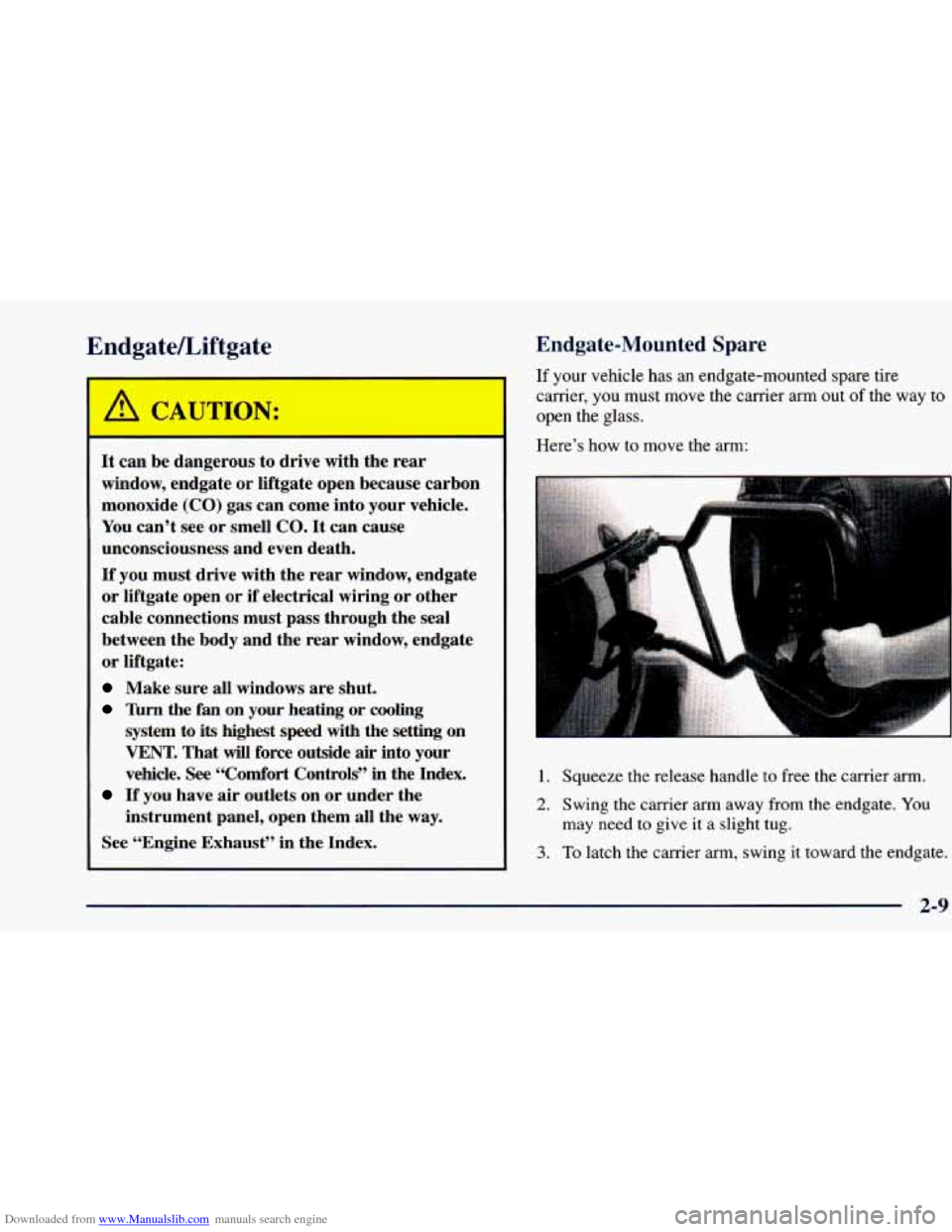
Downloaded from www.Manualslib.com manuals search engine EndgateLiftgate
It can be dangerous to drive with the rear
window, endgate or liftgate open because carbon
monoxide
(CO) gas can come into your vehicle.
You can’t see or smell
CO. It can cause
unconsciousness and even death.
If you must drive with the rear window, endgate
or liftgate open or
if electrical wiring or other
cable connections must pass through the seal
between the body and the
rear window, endgate
or liftgate:
Make sure all windows are shut.
lhrn the fan on your heating or cooling
system to its highest speed with the setting on
VENT. That will force outside air into your
vehicle. See
64C~~0~ Controls’’ in the Index.
instrument panel, open them all the way.
If you have air outlets on or under the
See “Engine Exhaust” in the Index.
Endgate-Mounted Spare
If your vehicle has an endgate-mounted spare tire
carrier, you must move the carrier arm out
of the way to
open the glass.
Here’s how to move the arm:
1. Squeeze the release handle to free the carrier arm.
2. Swing the carrier arm away from the endgate. You
may need to give it a slight tug.
3. To latch the carrier arm, swing it toward the endgate.
2-9
Page 84 of 416
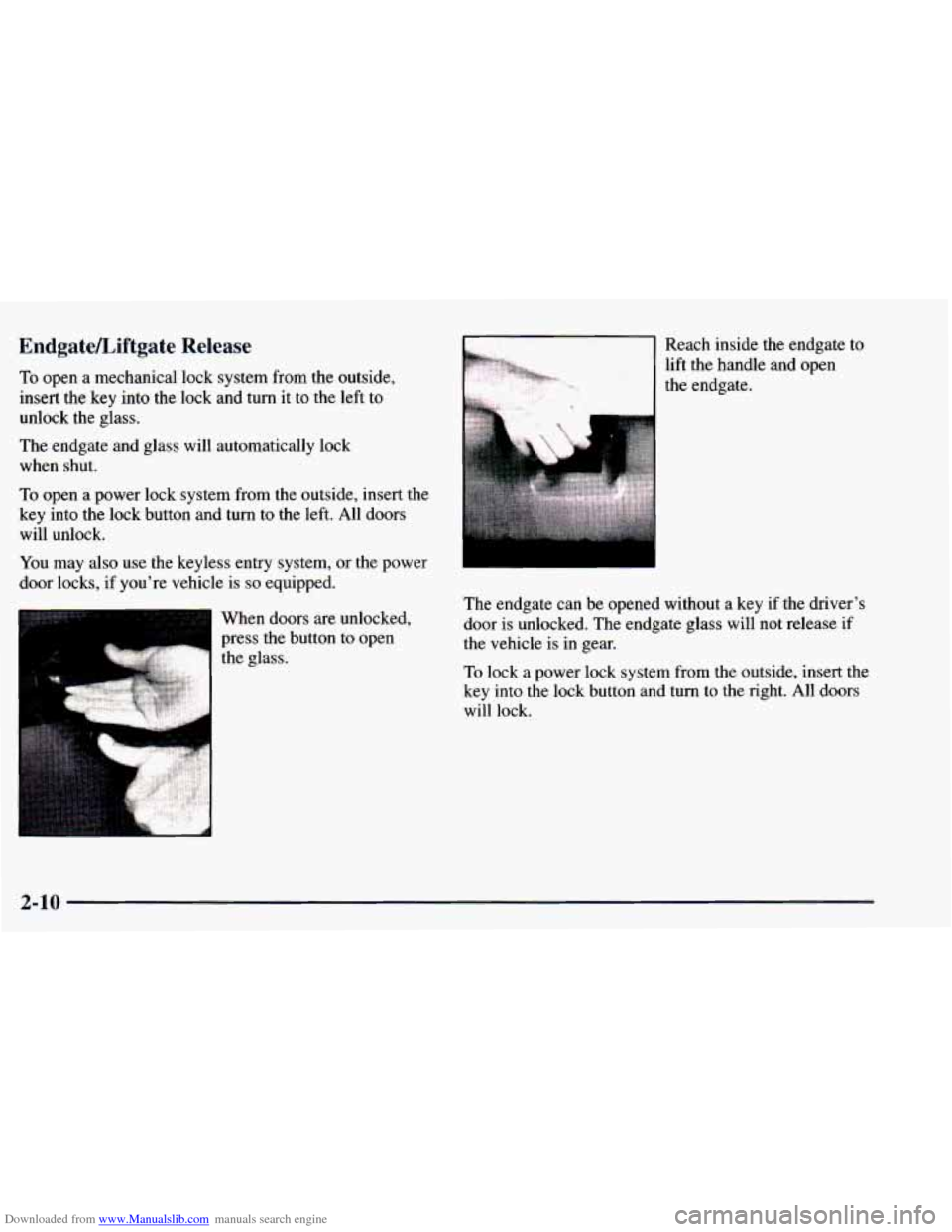
Downloaded from www.Manualslib.com manuals search engine EndgateLiftgate Release
To open a mechanical lock system from the outside,
insert the key into
the lock and turn it to the left to
unlock the glass.
The endgate and glass will automatically lock
when shut.
To open a power lock system from the outside, insert the
key into the lock button and turn to the left. All doors
will unlock.
You may also
use the keyless entry system, or the power
door locks,
if you’re vehicle is so equipped.
When doors are unlocked,
press the button to open
the glass.
I
Reach inside the endgate to
lift the handle and open
The endgate can be opened without a key
if the driver’s
door is unlocked. The endgate glass will not release if
the vehicle is in gear.
To lock a power lock system from the outside, insert the
key into the lock button and
turn to the right. All doors
will lock.
2-10
Page 85 of 416
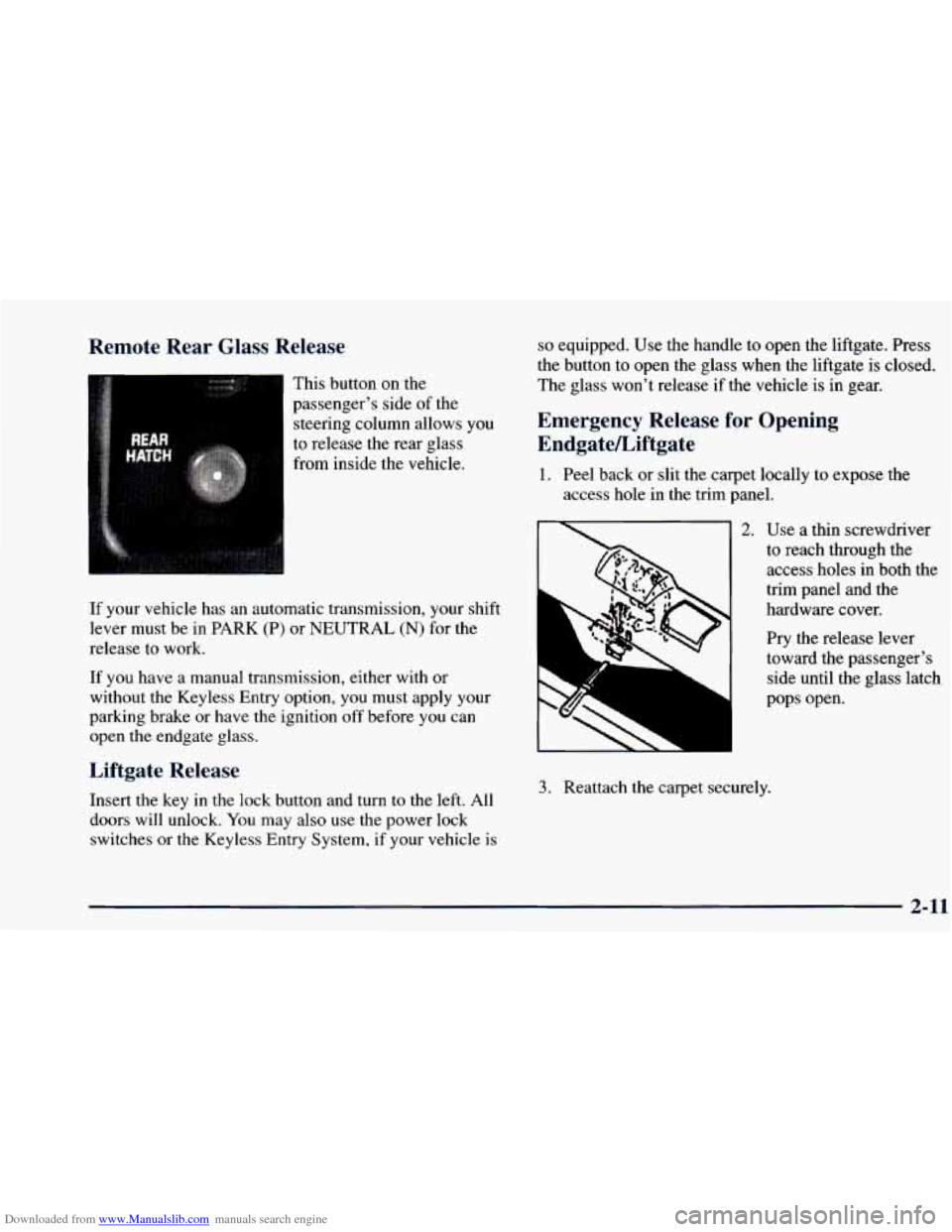
Downloaded from www.Manualslib.com manuals search engine Remote Rear Glass Release
1
This button on the
passenger’s side
of the
steering column allows you
to release the rear glass
If your vehicle has an automatic transmission, your shift
lever must be in PARK (P)
or NEUTRAL (N) for the
release to work.
If
you have a manual transmission, either with or
without the Keyless Entry option, you must apply your
parking brake or have the ignition off before you can
open the endgate glass.
so equipped. Use the handle to open the liftgate. Press
the button to open the glass
when the liftgate is closed.
The glass won’t release if the vehicle
is in gear.
Emergency Release for Opening
EndgateLiftgate
1. Peel back or slit the carpet locally to expose the
access hole in the trim panel.
11 2. Use a thin screwdriver
to reach through the
access holes in both the
trim panel and the
hardware cover.
Liftgate Release
Insert the key in the lock button and turn to the left. All
doors will unlock. You may also use the power lock
switches or the Keyless Entry System,
if your vehicle is
3. Reattach the carpet securely. Pry
the release lever
toward the passenger’s
side until the glass latch
pops open.
2-11
Page 86 of 416
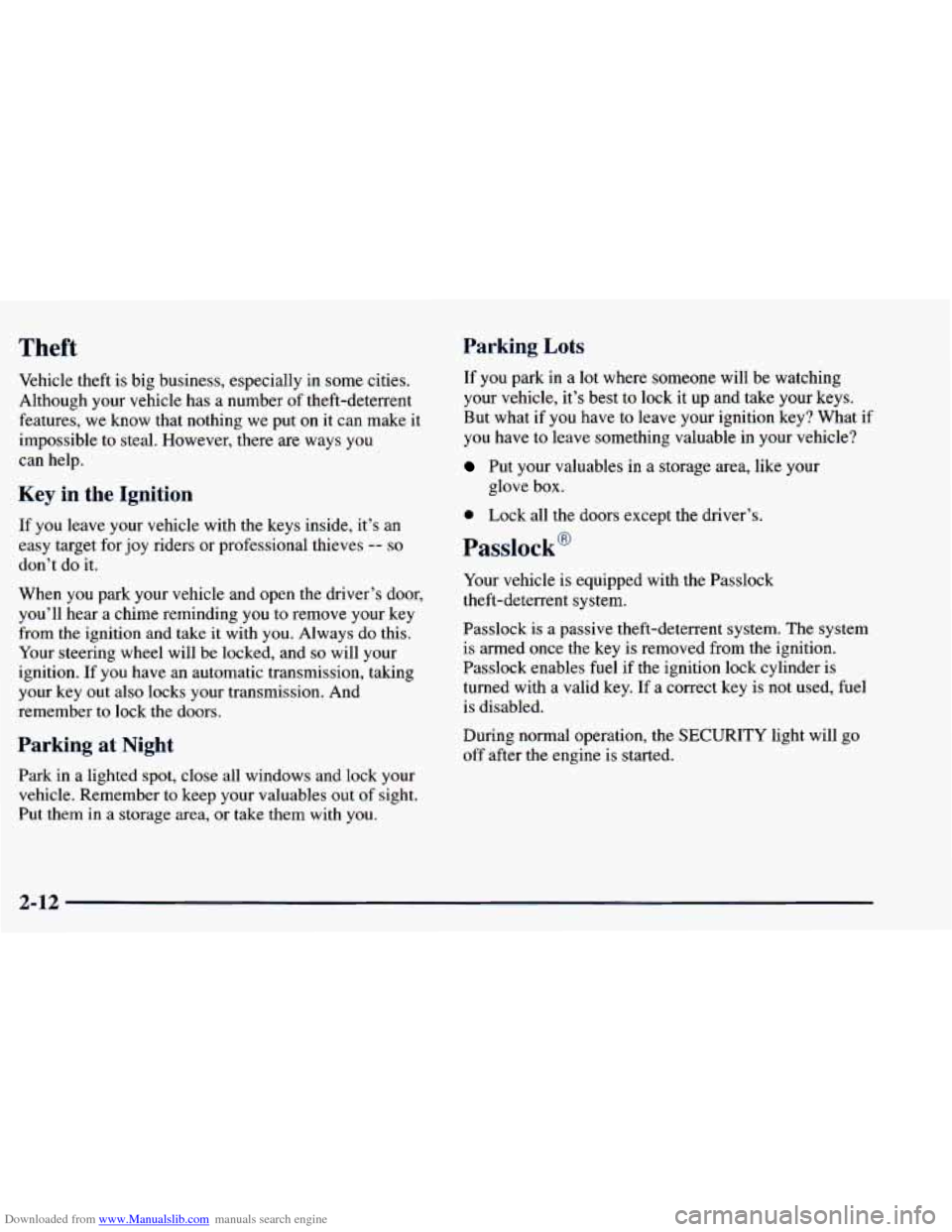
Downloaded from www.Manualslib.com manuals search engine Theft Parking Lots
Vehicle theft is big business, especially in some cities.
Although your vehicle has a number of theft-deterrent features, we know that nothing we put on it can make it
impossible to steal. However, there are ways you
can help.
Key in the Ignition
If you leave your vehicle with the keys inside, it’s an
easy target for joy riders or professional thieves
-- so
don’t do it.
When you park your vehicle and open the driver’s door, you’ll hear a chime reminding you to remove your key
from the ignition and take it with you. Always
do this.
Your steering wheel will be locked, and
so will your
ignition. If you have an automatic transmission, taking
your key out also locks your transmission. And
remember to lock the doors.
Parking at Night
Park in a lighted spot, close all windows and lock your
vehicle. Remember to keep your valuables out of sight.
Put them in a storage area, or take them with
you.
If you park in a lot where someone will be watching
your vehicle, it’s best to lock it up and take your keys.
But what if
you have to leave your ignition key? What if
you have to leave something valuable in your vehicle?
Put your valuables in a storage area, like your
glove box.
0 Lock all the doors except the driver’s.
Passlock@
Your vehicle is equipped with the Passlock
theft-deterrent system.
Passlock is a passive theft-deterrent system. The system
is armed once the key is removed from the ignition.
Passlock enables fuel if the ignition lock cylinder is
turned with a valid key. If a correct key is not used, fuel
is disabled.
During normal operation, the
SECURITY light will go
off after the engine is started.
2-12
Page 87 of 416
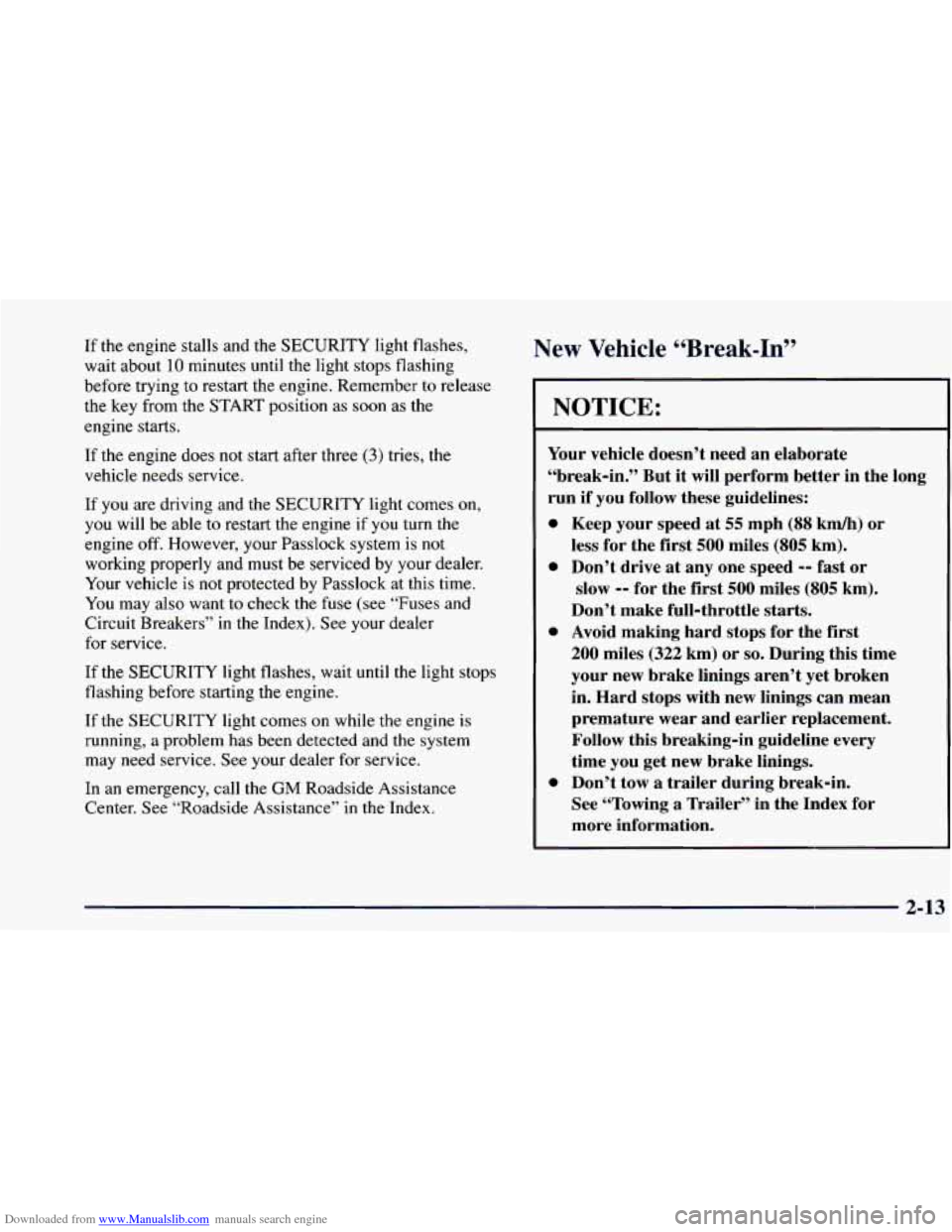
Downloaded from www.Manualslib.com manuals search engine If the engine stalls and the SECURITY light flashes,
wait about
10 minutes until the light stops flashing
before trying to restart the engine. Remember to release
the
key from the START position as soon as the
engine starts.
If the engine does not start after three (3) tries, the
vehicle needs service.
If you are driving and the SECURITY light comes on,
you will be able to restart the engine if you turn the
engine
off. However, your Passlock system is not
working properly and must be serviced by your dealer.
Your vehicle is not protected by Passlock at this time.
You may also want to check the fuse (see “Fuses and
Circuit Breakers” in the Index). See your dealer
for service.
If the
SECURITY light flashes, wait until the light stops
flashing before starting the engine.
If the
SECURITY light comes on while the engine is
running, a problem has been detected and the system
may need service. See your dealer for service.
In an emergency, call the
GM Roadside Assistance
Center. See “Roadside Assistance” in the Index.
New Vehicle “Break-In”
NOTICE:
Your vehicle doesn’t need an elaborate
“break-in.” But
it will perform better in the long
run if
you follow these guidelines:
a
0
0
0
Keep your speed at 55 mph (88 km/h) or
less for the
first 500 miles (805 km).
Don’t drive at any one speed
-- fast or
slow -- for the first 500 miles (805 km).
Don’t make full-throttle starts.
Avoid making hard stops for the first
200 miles (322 km) or so. During this time
your new brake linings aren’t yet broken
in. Hard stops with new linings can mean
premature wear and earlier replacement.
Follow this breaking-in guideline every
time
you get new brake linings.
Don’t tow
a trailer during break-in.
See “Towing a Trailer’’ in the Index for
more information.
2-13
Page 88 of 416
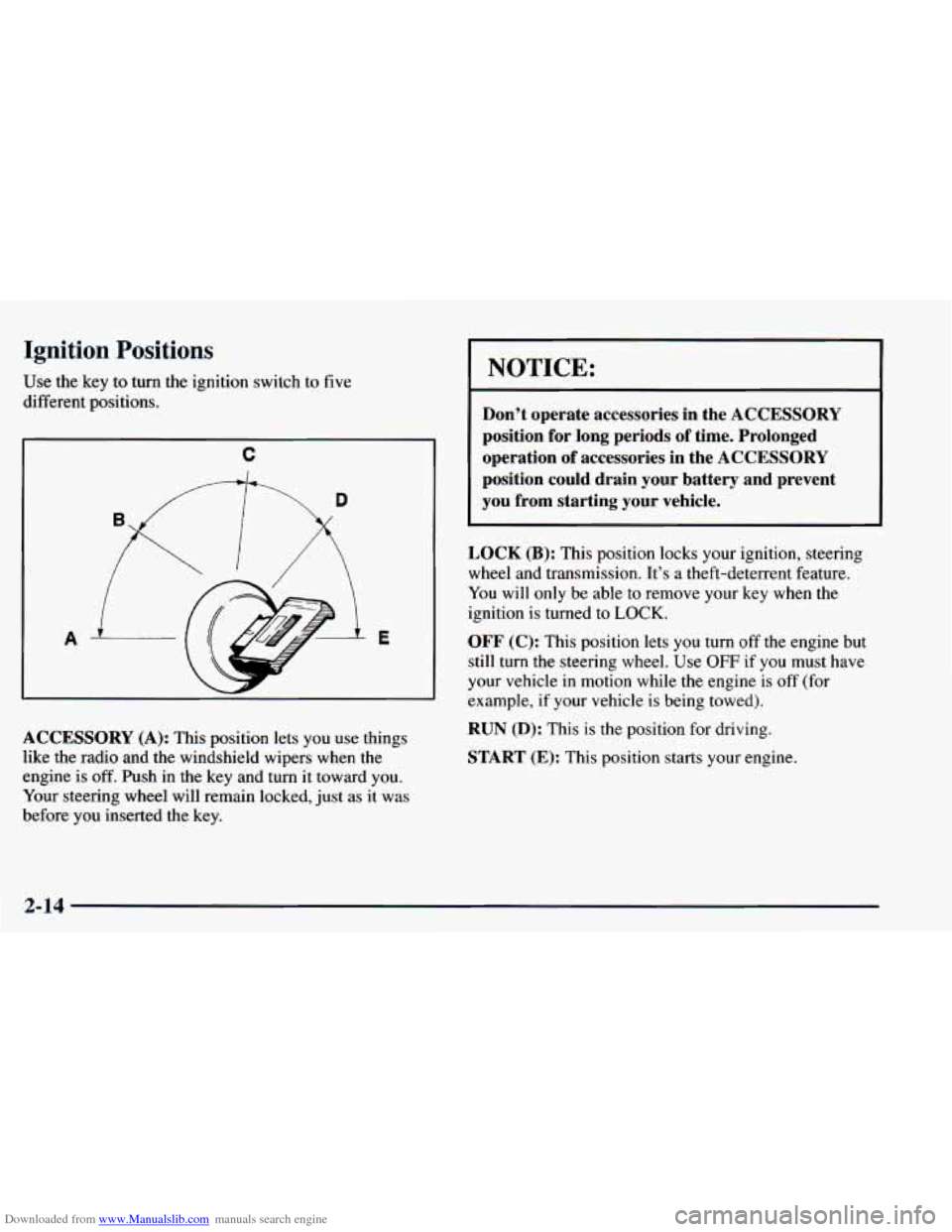
Downloaded from www.Manualslib.com manuals search engine Ignition Positions
Use the key to turn the ignition switch to five
different positions.
P
C
A
LCCESSORY (A): This position lets you use things
like the radio and the windshield wipers when the
engine is
off. Push in the key and turn it toward you.
Your steering wheel will remain locked, just as
it was
before you inserted the key.
-
NOTICE:
Don’t operate accessories in the ACCESSORY
position for long periods of time. Prolonged
operation of accessories in the ACCESSORY
position could drain your battery and prevent
you from starting your vehicle.
LOCK
(B): This position locks your ignition, steering
wheel and transmission. It’s a theft-deterrent feature.
You will only be able to remove your key when the
ignition is turned to
LOCK.
OFF (C): This position lets you turn off the engine but
still turn the steering wheel.
Use OFF if you must have
your vehicle in motion while the engine is off (for
example,
if your vehicle is being towed).
RUN (D): This is the position for driving.
START (E): This position starts your engine.
2-14
Page 89 of 416
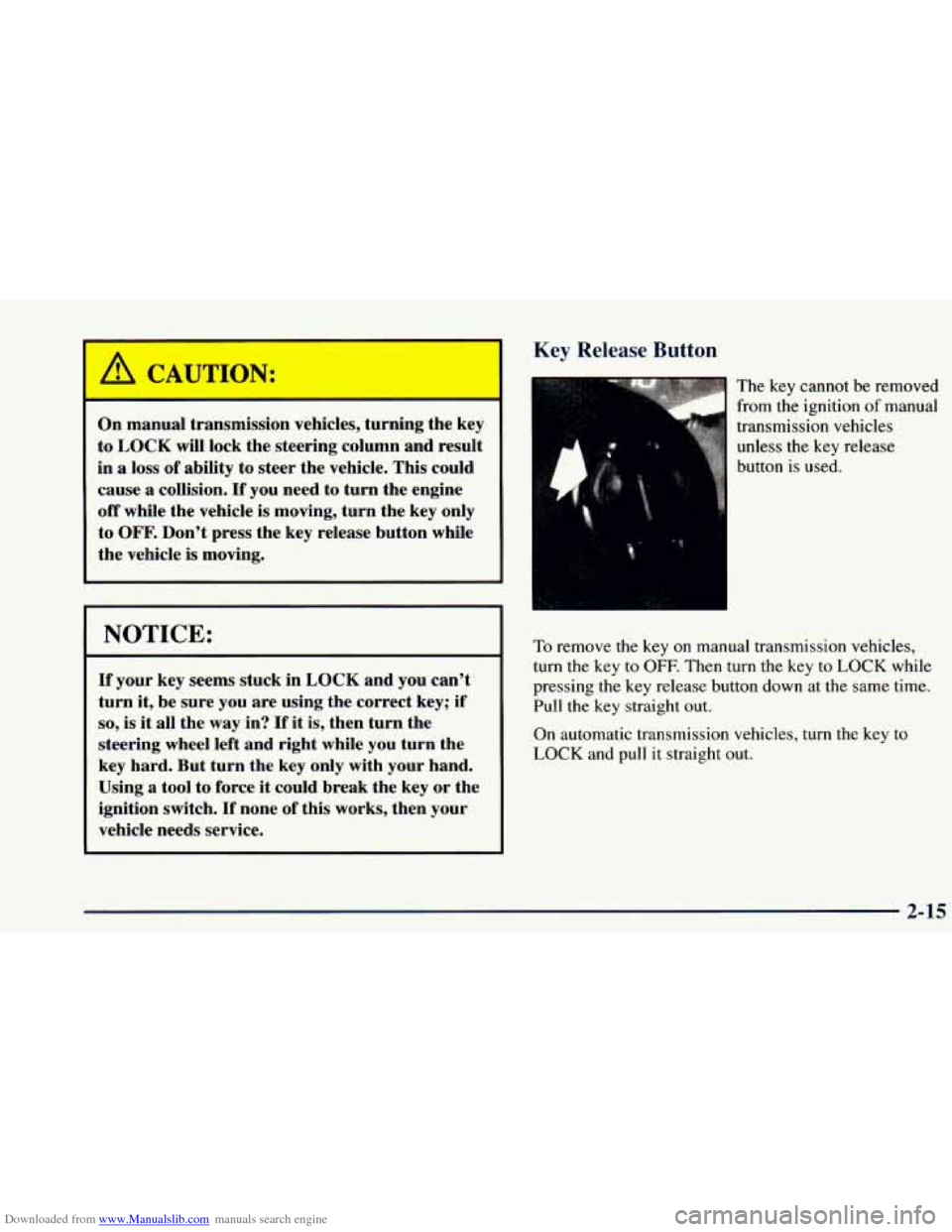
Downloaded from www.Manualslib.com manuals search engine ’
A CAUTION:
On manual transmission vehicles, turning the key
to
LOCK will lock the steering column and result
in
a loss of ability to steer the vehicle. This could
cause
a collision. If you need to turn the engine
off while the vehicle is moving, turn the key only
to
OFF. Don’t press the key release button while
the vehicle
is moving.
I NOTICE:
If your key seems stuck in LOCK and you can’t
turn it, be sure you are using the correct key; if
so, is it all the way in? If it is, then turn the
steering wheel left and right while you turn the
key
hard. But turn the key only with your hand.
Using
a tool to force it could break the key or the
ignition switch.
If none of this works, then your
vehicle needs service.
Key Release Button
The kev cannot be removed ,
from the ignition of manual
transmission vehicles
unless the key release
To remove the key on manual transmission vehicles,
turn the key to OFF. Then turn the key to LOCK while
pressing the key release button down at the same time.
Pull the key straight out.
On automatic transmission vehicles, turn the key to
LOCK and pull it straight out.
2-15
Page 90 of 416
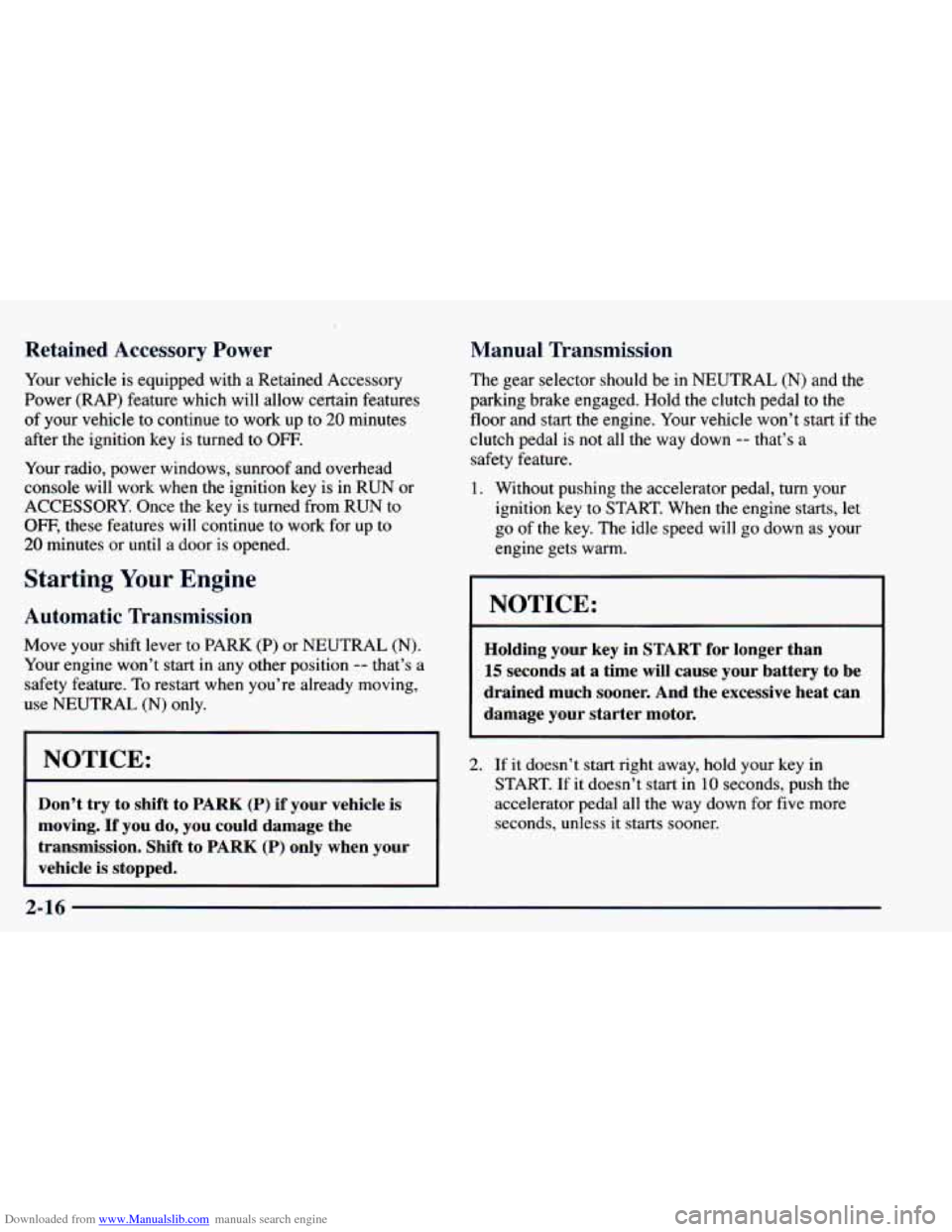
Downloaded from www.Manualslib.com manuals search engine Retained Accessory Power
Your vehicle is equipped with a Retained Accessory
Power (RAP) feature which will allow certain features
of your vehicle to continue to work up to
20 minutes
after the ignition key is turned to
OW.
Your radio, power windows, sunroof and overhead
console
will work when the ignition key is in RUN or
ACCESSORY. Once the key is turned from
RUN to
OFF, these features will continue to work for up to
20 minutes or until a door is opened.
Starting Your Engine
Automatic Transmission
Move your shift lever to PARK (P) or NEUTRAL (N).
Your engine won’t start in any other position -- that’s a
safety feature.
To restart when you’re already moving,
use NEUTRAL
(N) only.
NOTICE:
Don’t try to shift to PARK (P) if your vehicle is
moving.
If you do, you could damage the
transmission. Shift to PARK
(P) only when your
vehicle is stopped.
Manual Transmission
The gear selector should be in NEUTRAL (N) and the
parking brake engaged. Hold the clutch pedal to the
floor and start the engine. Your vehicle won’t start
if the
clutch pedal
is not all the way down -- that’s a
safety feature.
1. Without pushing the accelerator pedal, turn your
ignition key to START. When the engine
starts, let
go of the key. The idle speed will go down as your
engine gets warm.
NOTICE:
Holding your key in START for longer than
15 seconds at a time will cause your battery to be
drained much sooner. And the excessive heat can
damage your starter motor.
2. If it doesn’t start right away, hold your key in
START. If it doesn’t start in 10 seconds, push the
accelerator pedal all the way down for five more
seconds, unless it starts sooner.
2-16